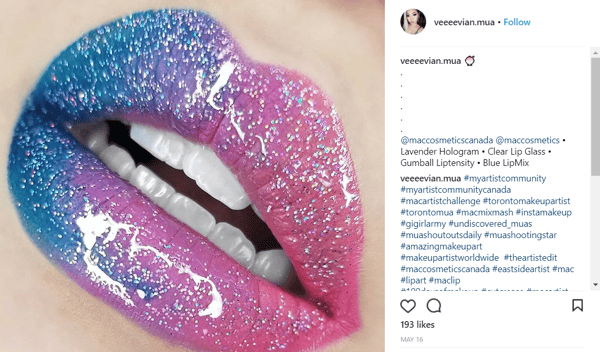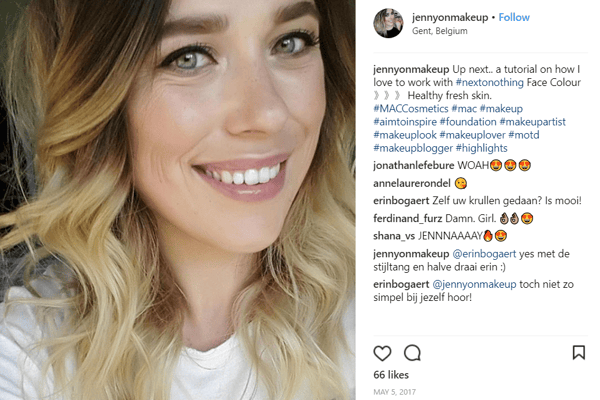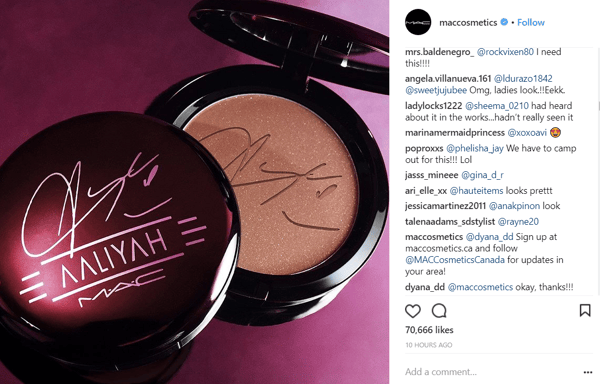
Q&A: In Conversation With The Biggest Beauty Brand on Instagram
The former ED of Global Consumer Marketing for MAC Cosmetics, Christina Peirona, shares her thoughts on engaging a global influencer network, how listening to consumers on social led to the creation of the upcoming MAC X Aaliyah summer collection, and what it took to recreate Lady Gaga's Super Bowl red glitter eyes.
At #SMWNYC 2018, BrandBastion CEO Jenny Wolfram hosted a fireside chat with Christina Peirona, former Executive Director of Global Consumer Marketing for MAC Cosmetics.
At over 18 million followers, MAC’s Instagram account is the most-followed beauty brand on the surging social network. Their page has blossomed thanks to a vast influencer network, great engagement, and a low number of vitriolic troll posts which have become common on the internet.
For those who missed the conference, we put together the Q&A transcript of the best highlights from the fireside chat. Read on for the nitty-gritty of how MAC grew their follower base from 1 to 18 million and successfully addressed animal testing accusations, lowering the frequency of such accusations from 25% to 2%! (Prefer to watch a video? Full recording here.)
Wolfram: Tell us a bit about your career and how you've seen the industry evolving.
Peirona: I started off on the agency side, working at a creative agency and developing strategy. My first brand I worked on was Elizabeth Arden.
Ten years ago, social was a very different story. It was not having to think about how we speak to consumers every single day, but more of when we launch something, how do we present it, how do we move them down the funnel, and have those key points where we speak to them.
After Elizabeth Arden, I moved to New York to work on Christian Dior. Then I moved to managing brands within the LVMH portfolio, such as Make Up For Ever and Benefit, and then ultimately ended up at MAC Cosmetics as the Director of New Media (social).
When I started there, our Instagram had about 1.4 million followers, we were posting on average 1.7 times a week, and those posts were very much “here is the beauty shot of whatever we’re launching and here is the product shot of whatever we’re launching”.
Eventually, just having those shots alone was not enough. It wasn’t building a community. So at MAC Cosmetics, what we’ve been doing over the past four years is figuring out how to build a community where it wasn’t just about pushing out information to users, but really listening to them and figuring out what inspires them and having a conversation.
In beauty, over the past ten years, it’s become much more of a conversation instead of pushing things out to people. The consumers are the ones driving the conversation; we’re there to listen and to have a perspective as a brand on what we stand for.
Thinking back, what has been one of the most successful social media campaigns you’ve been involved in and how did you get the idea for it?
Something we did at MAC two years ago was a campaign called #MACMixMash. At MAC, we have two audiences - your general consumers and the make-up artists. They kind of blend a little bit, but we wanted to see what’s happening with the make-up artists every day, and where is the line melding with what our customers are coming to us for.

We realized that our make-up artists never wore just one lipstick color. Everyone kind of had their ‘secret sauce’ for mixing lipstick and liner colors. As a consumer, you just grab the one lipstick and put it on. We saw an opportunity to share what our make-up artists were doing with our regular customers to be able to customize their style.
We launched the campaign, asked people to use the hashtag. We have our “internal influencer network” with 25,000 artists globally - we asked them to start using it and we saw great success. It propelled our follower count from 7 to 8 million in a pretty quick timeframe. Our artists were participating because they knew they were getting regrammed - it really became a community effort. I think there are still 40,000 people using the hashtag to share their creative ideas.
When it comes to finding influencers and tapping into them, what should companies be thinking about?
With influencers, the most important thing is not to go with who has the biggest following or who you like personally, but who, when you look at their feed and their audience, there’s something that aligns with what you’re trying to do as a brand.
At MAC, there are 90 collections launched a year, huge volume - somebody that is going to buy your sparkly lipgloss is not necessarily the same person buying your mascara. When thinking about what influencer you need, it’s about looking at people who are already posting similar things, whose feed has a similar aesthetic to what you are trying to get across, rather than someone who is a total departure from what you’re aiming for.
For example, with our Next To Nothing launch, it was a very thin, light skin color, intended to let your true skin color shine through - not what you’d typically think when you think of MAC. Our typical “drag queen”, heavy foundation types of influencers were not going to work for that. It had to be more lifestyle-oriented, and so we had to look for influencers who would connect with the product and the lifestyle it was offering.

When it comes to working with them - instead of being too prescriptive and saying “Here’s three things we want you to do and say”, we keep it quite loose and say, “Here’s what we’re doing as a brand, we love these things you’ve done - come up with something in between, your call.” It empowers them and motivates them to do more. Sometimes we ask for one post, and we get five posts and a few Stories and we are blown away by how excited they are just to partner with us.
Additionally, what should brands be doing if their audience has a negative reaction towards an influencer or ambassador representing the brand?
That’s what you guys helped us with!
I think it’s important to understand your audience and why they’re responding the way they are. We once posted a regram and a lot of our artists were very upset about it. We had to really pedal back and understand what were some of the things that influencer had done that made the artist community unhappy that we were supporting that influencer.
Sometimes, you do have to issue an apology. Sometimes, you do have to archive that post and take it out of view so people aren’t continuing to blow it up. Sometimes, you have to stand by it and say, at MAC, we support all ages, all races, all genders even and we’re not going to stand for you guys saying these negative things about this person.
With social, you can see exactly why people are upset, you can see the conversations people are having, you can see who’s defending you, and you can gauge how to react from there. I think being actively engaged is key.
MAC Cosmetics is launching the Aaliyah Collection in June. Looking at social, it seems fans can hardly wait for this. How can brands know what they should be launching and doing? And how can you listen to that kind of feedback as it is being given?
Similar to what happened with Selena Quintanilla, there was a petition created, it got over 25,000 signatures saying “We want this collection”. It became a thing, and you (BrandBastion) can speak to this - literally every post that went up for a while, people just started commenting “#macforaaliyah #macforaaliyah #macforaaliyah”. We were tracking it and we just saw this groundswell, and internally, we were going, “We’re not going to do it, we’re not going to do it… we can’t not do it!”
So we eventually decided to do it… we saw the same thing as with Selena. We sold out within hours, there were lines and lines and lines for people to get the collection. It was all about listening to our consumers, and eventually, we couldn’t ignore it - they were that loud.

The fans went to her family, they went to her brother, her brother got on board, he was really excited - it all came down to listening to what people want. And social is the right place to do that. For instance, we saw our metallic collection coming from pretty far away, because when we were launching our mattes, people were already saying “It would be great if this had metallics in it”.
When it comes to planning campaigns in advance - how much do you think brands should be changing their direction or adapting as they go along, versus staying on track with your original plan?
Certainly the marketing calendar is built far out. We know that in April we’re going to be talking about skin, or whatever that might be. So you plan that out. But I think the most important thing in social, and what has kept MAC growing, is to be nimble, and to be scrappy. Those polished videos that look beautiful, they belong in ads maybe - they don’t belong in Instagram.
One of the things we’ve done at MAC comes from the luxury of having 25,000 artists around the globe. We can run to a MAC Pro store and be like “Gosh, we’re seeing blue lips everywhere, and we don’t have any content on blue lips - can you just film something for us really fast?” and pulling it together that same day.
When Lady Gaga wore that red glitter eye at the Super Bowl, we went to the MAC Pro store that Monday morning, filmed a “How To” on an iPhone, and put it up that same day. Everyone’s like, “Your budgets must be crazy!” No, we are just totally willing to try, fail, and just get something up.
Out there, there’s a girl sitting in her bedroom, filming a “How To” and it’s probably nearly not as perfect as a professional artist, and it’s getting a bajillion views. There is no reason that as a brand, we can’t just do the same thing and get that content up.
Plan it out, have those ideas, know that in May you’re going to be talking about lipstick, but if you see a crazy eye trend coming up, don’t be afraid to go away from that, and get something up.
In 2017, fake news, hate speech, and trolling were quite central themes when it comes to social media.
Do you see these trends impacting the beauty industry and what are your thoughts on how brands can take an active role in fighting these negative things on social?
Animal testing. MAC does not test on animals. But that is something that for the past couple years, has been a thorn in our side with people saying that we do, and constantly posting fake pictures, such as the cat neutering photo from a neutering facility that is not in any way an animal testing facility nor is it connected to MAC - but it seems to surface constantly.
We brought in BrandBastion because it just got out of control. We couldn’t reply to every single post or comment, and it really hurt us. At some point, 24% of all the comments on our Instagram profile were animal testing comments. It was completely out of control. We brought you all in, and within a month, I think it dropped 7%, and within a couple months, it was down to like 2% of our comments.
And that was just through replying promptly and telling them the truth: “We don’t test on animals, we don’t own animal facilities. Yes, we do sell in China, where they reserve the right to test on animals, however, we don’t. Learn more here, here’s a link to our website where you can see all of our policies.”
Just by telling people that, they were replying and saying “Oh, thank you for telling me that. Oh, got it, okay.” Also, a lot of our followers started standing up for us and saying “This isn’t true, they don’t test” and defending the brand themselves.
Being open and honest and having those conversations led us to see a huge decrease in such animal testing comments - I think that is the best way to deal with that.
With the rise of AI and machine learning technology, what do you think are some of the things in social marketing that you think maybe humans do better?
and what are some of the things that you think the machines can soon take over?
I think for some things, like giving people information and links to where a store is located - a person doesn’t need to be replying for that.
In terms of the beauty industry, a lot of comments are artistry related - “Wow, that eyeliner is so fierce! How did you get that flick of the cat eye?” - that’s going to need a bit more of an explanation. “Oh, your eyes are green - you might want to wear more of purple eyeshadow versus this.”
There’s some information that machines can and should do. “How do I buy this? Where can I get this product?” - things that are pretty standard. In terms of talking about your brand, having fun with the brand, engaging with people - that’s something people want to talk to a human for. They want to feel like the brand cares about them. Especially for MAC, we don’t just comment on our own feed - we go to consumers feeds and leave comments like “This is really beautiful!” This needs to come from a person, I believe, because there needs to be a bit of personality to it.
There’s a balance - I think the tools and machines being developed out there will get better at these things. But for a brand to have a personality and be able to relate to consumers, that’s something that’s going to be easier for a human to do.
How can brands get better at posting up content that their audiences want to look at?
Don’t be afraid of putting up a bad post. It’s so ephemeral, you put up a bad post, it’s there, it’s gone, out of people’s feeds. If you get negative feedback, listen and adjust accordingly. Listen to your audience. Ask them questions. For people who are already commenting on your posts, it’s clear - they’re into you! So talk to them, have fun, engage with them in a fun and light way.
